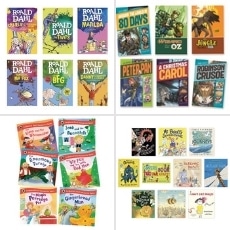Teachers spend a lot of time encouraging students to read in school. Some children develop a passion for reading at a young age and never lose it. Others love reading and then fall off the literature train as they get older and find other distractions. A lot dislike reading and aren’t afraid to say so.
The 21st Century has arguably made it more difficult to help children want to read for pleasure, but the benefits of reading are far-reaching meaning efforts as educators are more important than ever. Here are 16 ideas for helping children to develop a passion for reading for pleasure.
Teacher tips to encourage pupils to read for pleasure
- Be a reading role model
- Schedule a D.E.A.R
- Start a book club
- Fill their world with books
- Arrange an author visit
- Accept all readers are different
- Get the parents involved
- Donate a book on your birthday
- Embrace World Book Day
- Craft an amazing reading corner
- Run a reading challenge
- Make a book of the week display
- Create your own reading hashtag
- Work with your local library
- Write some book reviews
- Make reading a habit
1. Be a reading role model
As with most activities we expect children to partake in, it’s a good idea to model what good looks like. Help children envisage what a passion for reading looks like and how enriching it can be. It also helps to fend off any feelings of unfairness that young children often feel so intensely. “If I have to do it, why don’t you?”
2. Schedule a D.E.A.R
Many schools have adopted D.E.A.R (Drop Everything and Read) in an effort to encourage their pupils to read. This is a predetermined time, usually lasting 30 minutes or so, when every member of the school (that includes you teachers) drops what they are doing and reads.
It’s important here to get commitment from everyone, showing the way for children by setting an example and being that role model we spoke of in point one. As an added bonus, it gives you a chance to catch your breath from a stressful day and immerse yourself in a different world.
3. Start a book club
Book clubs are a popular part of many office environments and social clubs, and there is no reason why it can’t be a part of your school too. Be sure to get buy-in from pupils by giving them control of what book is chosen. After reading the book or just a few chapters, get together to discuss it. To add a bit of excitement, mix it up occasionally and create a bookmark or book jacket – anything to make those books feel a bit more precious.
If you think it won’t work on a regular basis, try special one-offs every now and then. That way, there is no big commitment involved.
4. Fill their world with books
Books, books, books. The more choice you provide pupils, the better. Although, if you do have pupils prone to feeling overwhelmed with too much choice, that’s where your classroom book corner can come in handy. Choose books for that corner that suite the tastes and needs of your class.
Before investing in new (or used – charity shops are great for when you’re tightening the purse strings) books, ask your class what books they like. If they say none, ask probing questions about their general tastes.
5. Arrange an author visit
Is there a local author in your region that might consider making an appearance in your school? Bringing someone as passionate and inspirational as the authors themselves is priceless when looking to enflame the imaginations of youngsters.
Plus, thanks to the joys of video conferencing, an author could call into your class remotely rather than having to travel to your school. It might just make the proposition more attractive to an especially busy author.
6. Accept all readers are different
Daniel Pennac’s book The Rights of the Reader is an interesting read for anyone hoping to encourage young people to read. His 10-point manifesto makes all circumstances of reading okay. Take one example, ‘The right not to finish a book.’ There can be huge pressure on all readers to finish a book they have started. But if that means a book takes months to finish, when we could have been reading many other more enjoyable books, is that helping to develop a passion for reading?
The Rights of the Reader puts enjoyment of reading at the centre of what’s important and that’s hopefully what we’re aiming for, here.
7. Get the parents involved
If you can get some interest from parents at home, you’ll go a long way to ensuring your pupils are reading for pleasure. Next time you see them, make sure you reinforce the importance of reading and how it can feed into every subject – not just English.
You could also give them a couple of takeaways on how they could encourage more reading at home. Ask them to try their own family version of D.E.A.R, or hand them a suggested reading list full of popular children’s books that are tailored to their child’s interests. Ultimately, encourage them to pull out a book and be a positive reading role model too.
8. Donate a book on your birthday
A nice idea we’ve seen from a couple of school replaces the tradition of bringing in chocolates or sweets on someone’s birthday. Instead, ask them to donate their favourite book to the school library, telling the class why it’s their favourite. Again, see if you can get all teachers and other staff members involved too.
9. Embrace World Book Day
Chances are your school already celebrates World Book Day but embracing it as best you can is one of the best ways to inspire pupils to love reading. Set the timetable to one side and throw your school into World Book Day and celebrate all the magical stories and characters that books have created.
There are no shortage of ideas for celebrating World Book Day in your school – but why not adapt some mentioned in the article and launch them on the big day?
10. Craft an amazing reading corner
Put ten minutes to one side and browse Pintrest and Instagram and you’ll be sure to find tonnes of ideas for giving your reading corner a fresh lift.
The importance of crafting an accessible, inviting reading corner in your classroom or school library can’t be understated. If it isn’t a nice environment to sit and relax in, you can’t expect pupils to engage with it.
One other point on reading corner – make sure it is well stocked! That doesn’t mean just books either, pack in some magazines and comics to broaden the appeal of reading corner. At the end of the day, reading is reading.
11. Run a reading challenge
A little friendly competition never hurt anyone. A reading challenge may be just what you need to incentivise some pupils to pick up a book. Give your class a goal and they’ll have a reason to read, rather than just because they “have to.”
It could be a checklist to read certain classics or a book from each genre, with prizes for those who do it. Or you could hold a photo competition, where pupils must recreate a famous scene from their favourite book.
12. Make a book of the week display
Find some space in a hallway and make it all about books! You could post updates from your reading challenge, new arrivals in the library, and put an individual’s book choices in the spotlight. Add a picture of a pupil or member of staff and ask them some questions about their favourite books.
13. Create your own reading hashtag
If you’re looking for ideas for older pupils, bringing social media into the fold could drive some extra engagement. Create a book-related hashtag for your school, (maybe just add books to the end of your school name, or come up with a cool nickname) and ask pupils to take a snap of them reading at home using the hashtag.
14. Work with your local library
If you’ve got a community library, you can work with them to make it easier for children to get involved and pay a visit. Ask them to make a trip to your school one day with library cards, taking down any barriers pupils have to taking books home.
You could make the trip over to the library one afternoon too, so they can get a feel and familiarity for the place and the people who work there.
15. Write some book reviews
Once a pupil has finished reading a novel they really enjoyed, encourage them to write about it. Ask them to draw up a short review explaining what it is they loved about the book and think of ways you can showcase their work. If you’ve got a book-related wall display, give it some exposure on there. Alternatively, if you’ve got a school paper, this is the perfect place to publish a book review.
As a secondary bonus, book reviews can be a great way to teach creative writing too.
16. Make reading a habit
Ultimately, each and every one of these tips is intended to feed into one big, overarching idea. Reading is fun! Whichever way you decide to encourage more reading for pleasure among your pupils, give it your full attention and the time it needs to make reading a regular habit.
Once they’ve been bitten by the reading bug, you’ll find children reaching for books in their social time more and more often.




